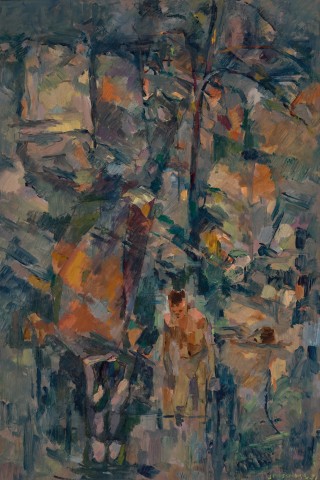THE RED ROCK, 1951
JOHN PASSMORE
oil on hardboard
91.5 x 61.0 cm
signed and dated lower right: J. PASSMORE 51
signed and inscribed with title verso: The Red Rock / J. Passmore
Douglas Watson, Sydney
Philip Bacon Gallery, Brisbane
Private collection, Sydney, acquired from the above in August 1985
John Passmore, Macquarie Galleries, Sydney, November – December 1951, cat. 5
John Passmore 1904 – 84 Retrospective, Art Gallery of New South Wales, Sydney, 19 December 1984 – 10 February 1985, cat. 18
Pearce, B., John Passmore 1904 – 84, Retrospective, Art Gallery New South Wales, Sydney, 1985, p. 45 (illus.)
John Passmore left Australia for Europe in 1933 and did not return for seventeen years. His years abroad were well spent gaining firsthand knowledge of the old masters and the upheavals in Western painting taking place in Europe and reverberating around the world.
When he returned to Australia in 1951, Passmore became the ‘Pied Piper’ of progressive painting through his various teaching roles, including at the National Art School in Sydney. He was a natural teacher; his wit and enthusiasm inspired his students to look beyond the academic brown Australian paintings of the day towards the innovations of Picasso, Matisse and Cézanne. A gaggle of devoted students hung on his every word and laughed along with his quick wit and humour. His passion for Tintoretto and Rembrandt was front and centre, but it was Cézanne whose influence gripped the artist very early and subsequently wove its way through his entire oeuvre.
Passmore’s friendship with the British painter Keith Vaughan inspired him to look closer at the works of Picasso and Matisse. This led them to revisit some early experimental cubist drawings the pair had developed in the 1930s while working together at Lintas advertising agency. Vaughan’s star was rising and in 1948 he had an exhibition at the Reid and Lefevre Gallery in London. The constructivist works in this exhibition signalled a shift back towards those earlier, cubist sketches he and Passmore had shared. Vaughan’s work from this time had an indelible impact on Passmore. Vaughan’s method of applying equal weight and value to figure, ground and colour, and his tug of war between realism and abstraction became central to Passmore’s work from this time forward.
In The Red Rock, 1951, the push and pull of the warm and cool colours create lush, deep, space that recedes to the distant upper left and draws forward toward the lower frontal third of the work. The two figures bathe carefree in an Idyllic surround. The reflective surface of the water proves to be a helpful pictorial device, allowing the artist to further fragment the light. Daubs of colour are used to pick out the figures, just enough to reward and satisfy the viewer’s scrutiny and need of subject, but once discovered the figures again dissolve into pockets of vibrant local colour. Passmore’s works from this period are some of the most complete paintings of his career. The painted surfaces are worked and reworked until they reach a finely tuned crescendo that quiver with nuance and feel. Passmore wore his influences on his sleeve and The Red Rock, 1951, is an excellent example of John Passmore via Cézanne and Keith Vaughan. At a stretch, we could consider a cameo of Rembrandt’s A Woman Bathing in a Stream, c.1654, for these are studio works and such references are entirely appropriate and legitimate.
The Red Rock, 1951 was included in John Passmore’s one-man exhibition at the Macquarie’s Galleries in 1951, an exhibition which marked his return to Sydney and to exhibiting. Notably, Passmore rarely had solo exhibitions, preferring instead the ‘cut and thrust’ of group exhibitions where contemporary works could be compared and critiqued. After all, through the 1960s and far beyond, Passmore’s reputation as a teacher had reached guru status, so the group show would provide him and his work a context where he was most comfortable.
HENRY MULHOLLAND
